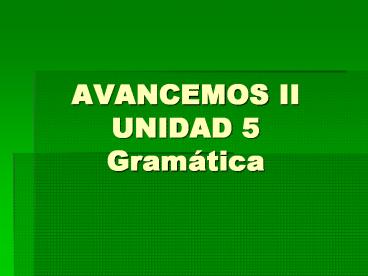AVANCEMOS II UNIDAD 5 Gram - PowerPoint PPT Presentation
1 / 12
Title:
AVANCEMOS II UNIDAD 5 Gram
Description:
AVANCEMOS II UNIDAD 5 Gram tica ~ simo(s), ~ sima(s), p. 258 To add emphasis to some adjectives, you can attach the ending ~ simo(a)(os)(as). If the adjective ... – PowerPoint PPT presentation
Number of Views:43
Avg rating:3.0/5.0
Title: AVANCEMOS II UNIDAD 5 Gram
1
AVANCEMOS IIUNIDAD 5Gramática
2
ísimo(s), ísima(s), p. 258
- To add emphasis to some adjectives, you can
attach the ending ísimo(a)(os)(as). - If the adjective ends in a vowel, drop it before
adding the ending. - Ejemplo bello(a)gt Esta cocina es bellísima!
(This kitchen is very (extremely) beautiful!) - When the last consonant in the adjective is c,
g, or z, spelling changes are required before
adding ísimo (a, os, as). - c gt qu ricogtriquísimo
- g gt gu largogtlarguísimo
- z gt c felizgtfelicísimo Completa Act. 5,
p. 258
3
Usted/Ustedes commandsMandatos formales, p. 259
- Used for respectful commands. Commands require a
change in verb endings.
Infinitive Present tense Usted Ustedes
probar(ue) yo pruebo pruebe prueben
comer yo como coma coman
añadir yo añado añada añadan
Pruebe el té. (Taste the tea.)
Coman la merienda. (Eat the snack.) Add
no before the verb to make commands negative.
(No coman la merienda. Do not eat the snack.)
4
Irregular usted/ustedes commands
dar (to give) estar (to be) ir (to go) saber (to know) ser (to be)
usted dé esté vaya sepa sea
ustedes den estén vayan sepan sean
Vaya a la cocina. (Go to the kitchen.)
No estén tristes. (Dont be sad.)
5
car, gar, zar verbs
- These verbs have a spelling change in the command
form.
buscar busque
pagar pague
empezar empiece
Completa Actividad 6, p. 260
6
Pronoun placement with commands, p. 264
- Placement depends on whether the command is
affirmative or negative. - With affirmative commands, pronouns are attached
to the end of the verb. - Llévenos al supermercado. (Take us to the
supermarket.) - Pónganlas en la mesa. (Put them on the table.)
An accent is added to the stressed vowel of the
command of two or more syllables.
7
Negative commands object pronoun placement
- Object pronouns are placed BEFORE the verb and
after no - No le venda esta camisa. (Dont sell her/him this
shirt.) - No lo prueben. (Dont taste it.)
- Completa Actividad 13, p. 265
8
Affirmative Negative words, p. 283
- Indefinite words that refer to non-specific
people, things, or situations can be affirmative
or negative.
Affirmative words Negative words
algo something nada nothing
alguien someone nadie no one
algún/ alguno(a)(s) some ningún/ ninguno(as)(s) none, not any
oo eitheror nini neithernor
siempre always nunca never
también also tampoco neither, either
9
Rules of affirmative/negative words
- Alguno(a) and ninguno(a) have different forms
before masculine singular nouns. - alguno gt algún ninguno gt ningún
- Quieres algún filete? (Do you want some steak?)
- No, no quiero ningún plato con carne. (No, I do
not want any dish with meat.)
10
- A double negative is required in Spanish when
no comes before the verb. Indefinite words
that follow no must be negative. - No veo nada. (I do not see anything.)
- When alguien or nadie is the object of a
verb, it is preceded by the personal a. - Conoces a alguien de España? (Do you know anyone
from Spain?) - No, no conozco a nadie de España. (No, I do not
know anyone from Spain.) - Completa Actividad Actividad 6, p. 284
11
Double object pronouns, p. 288
- For placement of both direct and indirect object
pronouns in the same sentence. - The indirect object pronoun comes first.
- La camarera nos trajo el caldo a Juan y a mí. gt
The waitress brought the broth to Juan and me. - La camarera nos lo trajo. gt The waitress brought
it to us. - 2. When a conjugated verb appears with an
infinitive or a verb in the ndo form, you can
put the pronouns before the conjugated verb OR
attach them to the infinitve or ndo form. - Me los vas a pedir. OR Vas a pedírmelos. (You
are going to ask me for them.)
12
- Me los estás pidiendo. OR Estás pidiéndomelos.
(You are asking me for them.) - When attaching pronouns, you must add an accent
to the stressed vowel. - 3. If both pronouns start with the letter l,
change the indirect object to se. - Le pedí la cuenta al camarero. gt Se la pedí. (I
asked him for it.) - Les puedes llevar el té a esas mujeres? gt
Puedes llevárselo? (Can you take it to them? - Completa Activitad 13 14, p. 289










![Nehru Gram Bharati Vishwavidyalaya - [NGBV], Allahabad PowerPoint PPT Presentation](https://s3.amazonaws.com/images.powershow.com/9682513.th0.jpg?_=20211111082)




















